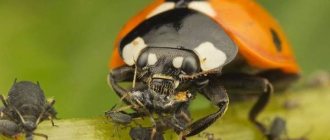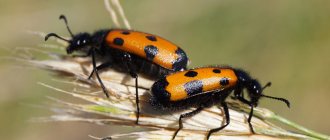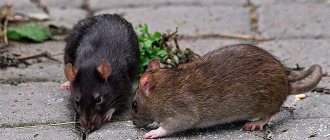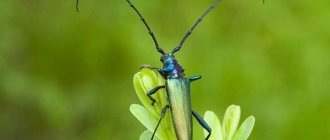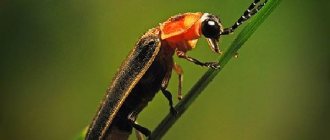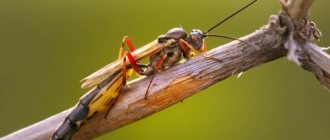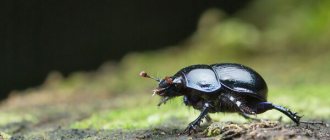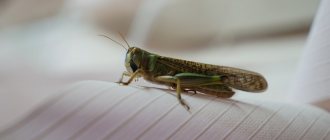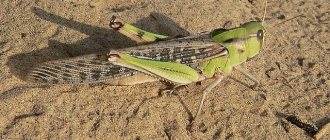- Ladybug: description, structure, characteristics. What does a ladybug look like?
Ladybug, fly to heaven, bring us bread, black and white, but not burnt. (Children's song).
Among all the insects that live in our latitudes, it is the ladybug that enjoys the greatest respect and honor. After all, even the name itself - “ladybug” speaks of a certain divinity of this creature. Why is the ladybug a ladybug? What habits does this insect have, what types of ladybugs are there, where they live, what they eat and many other interesting things about them, read on.
What does it look like?
The insect has a rounded, egg-shaped body, flattened at the bottom and convex at the top.
Juveniles most often have a bright red color (but other colors also exist).
On the back of the ladybug there are black dots with a diameter of 1–2 mm. However, their number varies and depends on the type of insect.
The body size ranges from 4 mm to 1 cm (maximum).
There are also flexible multi-segmented antennae and hard, expressive elytra. Interesting fact! When flying, an insect makes an average of 85 beats per second.
Description, structure, characteristics
According to the biological classification, the ladybug is an arthropod insect that belongs to the Coleoptera and the family of ladybirds.
The size of a ladybug ranges from 4 to 10 mm. The shape of their body is either round or oval-elongated, flat below and very convex above. The body surface of some types of ladybugs is covered with fine hairs. The structure of their body includes a head, a pronotum, a chest consisting of three sections, an abdomen, wings with elytra and three pairs of paws.
The ladybug's head is small (although in some species it may be slightly elongated), it is motionlessly connected to the anterior chest. But the ladybug's eyes are relatively large. The insect's antennae, which consist of 8-11 segments, are highly flexible.
The ladybug's pronotum is convex, has a transverse structure and a notch at the anterior edge. On its surface there are often “signature” spots of different shapes.
Thanks to the presence of three pairs of paws, the ladybug can move quite quickly both on the grass and along plant stems. The abdomen of ladybugs consists of five or six segments, which are covered from below by sternites (segmental semirings).
Despite the fact that ladybugs have two pairs of wings, they fly only with the help of their two hind ones. The front wings, in the process of evolution, were transformed into hard elytra, which serve as protection for the hind wings at the moment when the ladybug is on the ground.
As a means of protection against predators, ladybugs are capable of secreting a kind of poisoned “milk” - cantharidin, a toxic yellow liquid that also has an unpleasant odor. Additionally, the bright colors of the ladybug scare away enemies. The color of the ladybug's protective covers can be not only bright red, but also yellow, black, white with spots of different colors and different configurations. Sometimes the pattern on the pronotum of a cow can indicate its gender.
Origin of the species and population
The ladybug is an arthropod insect from the order Coleoptera. This bug received its scientific name (Coccinellidae) due to the scarlet coloring of its body. There are many varieties of ladybugs, and the entire family contains more than 4,000 species.
Over the past couple of decades, the population of ladybugs has decreased amid active control of aphids. And, as a result, the little red bugs had nothing to eat.
The situation became very sad when scientists made one irreparable mistake (of course, guided by good intentions). In order to maintain the population, millions of artificially raised individuals were released into the natural environment, which, due to existing gene mutations, dramatically changed their diet, choosing their own relatives as food. This resulted in the death of a huge number of beneficial bugs, so in all European countries their populations have noticeably decreased.
Varieties, their names, descriptions and photos
Below is a description of what ladybugs are, a detailed description of the most interesting varieties; You will also be able to see their photos, including close-up photos.
Point-to-point
The body length of the two-spot ladybug reaches about 5 mm. The color is dark red with two parallel black dots on the back (hence the characteristic name). The body has an oblong-oval, moderately convex shape.
The head of light-colored individuals is black, with two large irregularly shaped spots (near the eyes). Dark bugs have a completely black head.
Seven-point
The seven-spotted ladybird is one of the most common species in Europe . The body size is about 8 mm. The color is red, and there are 3 black spots on the sides. The seventh spot is located near the head.
Twelve-point
The twelve-spotted ladybird reaches 6 mm in length. It has a red or pink color. There are 6 black dots on each elytra. The insect lives primarily in North America and feeds on pollen from agricultural plants.
Thirteen-point
The thirteen-spotted ladybird has 13 spots on its surface. Color - red-brown or brick. In this case, some spots may merge with each other. The insect is common in Europe, Asia and North America.
Asian
The Asian ladybird or Harlequin reaches a length of 7 mm. It is either yellow-black or black-orange in color . The insect lives in Asia and feeds on aphids.
Note! This species is characterized by the greatest gluttony, therefore it is specially cultivated in Europe and North America to combat agricultural pests.
Ocellated
The ocellated ladybug is considered one of the largest and reaches a length of approximately 1 cm. The color is red or yellow. In this case, each of the spots is surrounded by a lighter halo. There are 20 such “eyes” on the back of the insect.
Pointless
The spotless ladybird is one of the rarest species , characterized by a complete absence of dark spots. The body of the insect is red or brown in color and covered with barely noticeable fibers. The insect reaches several millimeters in length.
Blue
The blue cow is the most unusual representative of this family. A distinctive feature of the insect is the blue color of the elytra with a characteristic metallic sheen. Dark spots on the back are absent (or simply not visible, because they merge with the dark blue color).
It lives in the eastern part of Australia, as well as in New Zealand. The insect feeds mainly on aphids. The body size does not exceed 4 mm.
Social structure and reproduction
Photo: Ladybugs
All ladybugs are solitary. Only during the mating season do males use a specific smell to look for a female to mate with. This usually happens in early spring and soon the female lays up to 400 eggs on the lower surface of the leaves. They are oval in shape and can be yellow or orange. The female chooses a place for laying closer to the aphid colony so that the offspring are provided with food. This is the only manifestation of caring for their offspring. Most often, she dies after this.
After a couple of weeks, the larvae appear. Their body is covered with hairs and has a variegated color; the pattern combines yellow and brown spots. In the first days, the larvae eat the remaining egg shells and unfertilized eggs, then go in search of aphids. The stage lasts from 4 to 7 weeks, after which the formation of a pupa occurs, which then attaches to the edge of the leaflet, where its further transformation occurs.
At the end of it, after 8-10 days, the skin peels off from the pupa like a stocking to the end of the abdomen. A full-fledged individual ladybug appears, which gradually acquires its usual bright color. At first, its elytra are pale in color; by this feature one can easily distinguish an adult from a young one. Young bugs are ready to reproduce at 3 months of life, some only at six months - it all depends on the quality of nutrition and environmental conditions.
What kind of lifestyle do they lead?
Regardless of the species, ladybugs lead a solitary life, showing a bright image of individualists . These insects are collected only for procreation. They also form flocks to fly to warm places (because they don’t like the cold).
But there are also sedentary individuals who huddle together during the winter in some secluded, abandoned place (under fallen bark, tree foliage, etc.). With the onset of warmth, they leave their shelter, scattering across meadows and clearings.
Nutrition
All ladybugs are predators, but the predators are very useful for humans, since they eat various harmful parasites: aphids,
ticks, small caterpillars. Sometimes during hunger they will not disdain even the eggs of the Colorado potato beetle. Some types of ladybugs also eat plant foods: mushroom mycelium, plant pollen, leaves and flowers of some trees.
Why is it called that?
Here are some of the versions of the origin of the name:
- In ancient times, the insect was personified with the thunder god - Perun.
The ladybug was credited with the ability to influence the weather and was perceived as a link between mortal people and the gods. - Catholics considered her a messenger of the Mother of God.
- The British associated the insect with the Virgin Mary.
But the most optimal and plausible version of why the bug was named so is that the insect secretes a poisonous white liquid (the so-called “milk”) to scare away predators. And “God’s”, probably because it helped fight aphids and other agricultural pests and did not harm humans.
Interesting fact! The Slavs considered the ladybug to be a direct messenger of the sun. Therefore, it was impossible to drive her away, much less kill her. Otherwise, you could “turn away” your luck.
Where does the name ladybug come from?
The ladybug received its unusual name due to its bright red color, which aroused the sympathy of people. So, for example, in Slovenia and the Czech Republic it was called the “sun” (Slunechko), in Germany and Switzerland it is known as the “Virgin Mary’s bug”, in Latin America it is called “St. Anthony’s cow”. What is the origin of the name “ladybug”, there are two versions in this regard, according to the first, it was called “ladybug” for its ability to secrete poisonous milk, which scares off potential predators; our ladybug received the prefix “ladybug” for its meek and peaceful disposition. According to another version, these insects became “God’s” due to their ability to destroy aphids, thereby helping to preserve the crop.
What does the bright warning color mean?
It is no coincidence that the ladybug is endowed with a bright color - it helps to survive in harsh natural conditions and scares away various enemies (predatory insects, birds, etc.). This is also a kind of mimicry, like a chameleon’s ability to adapt to the color of its environment (foliage, trees, sand, etc.) for the purpose of self-preservation.
And bright colors are warning signals for the wild world, indicating the inedibility and, possibly, toxicity of a potential victim. There is even a theory in the scientific world that goes something like this: “ The brighter the color of an insect, the less likely it is to be attacked by a predator .” Therefore, the red coloring looks something like a stop sign for all sorts of enemies. However, with age, the scarlet color fades.
Where do they live?
Ladybugs can be found in almost every corner of the world, with the exception of northern latitudes (Antarctica and other polar regions).
The active period of their life activity occurs in the spring-summer period, when there are a lot of aphids and other small insects that red bugs can feast on in abundance.
As for specific habitats, they feel most comfortable in open areas with lush vegetation (lawns, clearings, forest edges, etc.). Others prefer to live in reed thickets (along water bodies). The optimal temperature for insect life should be at least +10 degrees.
How and where do they winter?
As mentioned earlier, with the onset of autumn, some insects cluster in large groups, each of which numbers up to a million individuals. Initially, they look for secluded places (wood, dry leaves, stones, abandoned buildings, etc.), then they move there and wait for the arrival of spring. Other species, on the contrary, prefer to leave their usual habitats for the winter, flying like birds to the southern corners of the planet.
Attention! If you find “sleepy colonies” of insects, you should not disturb them. If they are somehow in the way (for example, they are in a barn, bathhouse, or some other place that will be used in the future for household needs), you need to carefully put them in a jar and move them to a comfortable place where they can safely spend the winter .
How do they reproduce, are born and develop?
Insects reach sexual maturity at approximately 3–6 months of life (depending on the species).
Their mating season begins with the arrival of spring. The female produces a characteristic odor, thanks to which the future chosen one finds her. Next, mating occurs, and the female lays eggs (most often near colonies of parasites to provide food for the offspring).
The eggs are oval in shape with slightly tapered ends. Color - yellow-orange. In one clutch, the female manages to lay about 400 eggs . After 1–2 weeks, the larvae are born.
The ladybug goes through the following stages of development:
- larva remains in this state for 1–2 months.
- The pupa attaches itself to the grass and spends 7–10 days in this position. It is during this period that the necessary parts of the body are formed.
- An adult lives from several months to 1–2 years.
Lifestyle
Ladybugs prefer to live “alone”, apart from other representatives of the species.
Only during the mating season do they come together to continue their family line. They also gather together for flights and wintering.
A ladybug can be called a fruit-loving bug, therefore, with the onset of a cold period, all insects living in temperate latitudes gather together and fly away to warm countries.
Among insects there is a sedentary species. They do not fly to countries with hot and dry climates, but gather in one place and winter in huge communities, reaching 400 million adult individuals. If you calculate how much such a “ball” weighs, you can get a figure equal to several tons.
To shelter from unfavorable climatic conditions, the “suns” hide in the ruins of stones and also take cover under fallen leaf blades of shrubs.
Under good conditions and the availability of food, spotted insects can live for 1 year. Under unfavorable conditions, the lifespan of insects does not exceed several months.
All about the benefits and harm
- The benefit of ladybugs is that they eat large quantities of parasites - pests of agricultural land. Therefore, they are specially bred at enterprises for the appropriate purpose.
- Herbivorous species of these insects can cause harm to humans , causing irreparable damage to agricultural crops (in particular potatoes, cucumbers, tomatoes and sugar beets). But most of these species live exclusively in tropical countries.
Interesting Facts
Here are some interesting facts about ladybugs:
- In ancient times, people were able to predict the weather with the help of red bugs.
So, if a cow quickly flew away from the palm, this foreshadowed bright and sunny weather in the future. If, on the contrary, the insect did not fly away anywhere and continued to sit on the hand, rain and thunderstorms were expected.
- In many countries, ladybugs are considered a symbol of good luck, so they should never be harmed. Otherwise, you can bring trouble on yourself and your family.
- Scientists still cannot solve the mystery of how ladybugs return each time after migrating to the same places where they lived in the warm season.
- At the beginning of the 19th century, in many European countries and the United States, specially trained people tracked the wintering sites of ladybugs and collected them in bags. In the spring, insects were released into the fields.
In this video, interesting facts about ladybugs will be presented in a fascinating and knowledgeable way, which may surprise someone and help to better “understand” these little red bugs.
Video
And finally, an interesting video about ladybugs.
Author: Pavel Chaika, editor-in-chief of Poznavaika magazine
When writing the article, I tried to make it as interesting, useful and high-quality as possible. I would be grateful for any feedback and constructive criticism in the form of comments on the article. You can also write your wish/question/suggestion to my email [email protected] or Facebook, with respect, the author.
Author page
Security
The ladybug is already listed in the Red Book in many countries, including Russia.
If this insect completely disappears, humanity will face an imbalance in nature and the active proliferation of dangerous pests, which will have to be destroyed chemically.
Therefore, today ladybugs are successfully bred in laboratory conditions , and then released into the fields. But in order to maintain balance, it is necessary to abandon the chemical destruction of aphids and direct general efforts to improve the ecological situation of the environment.
Ladybugs are amazing creatures of nature that bring great benefits to people (with the exception of herbivorous species). They protect crops from various kinds of parasites, thereby preserving the harvest and allowing humanity to do without chemicals. However, in recent years the number of these beneficial insects has noticeably decreased, so they are listed in the Red Book and attempts are being made to restore the population artificially.
